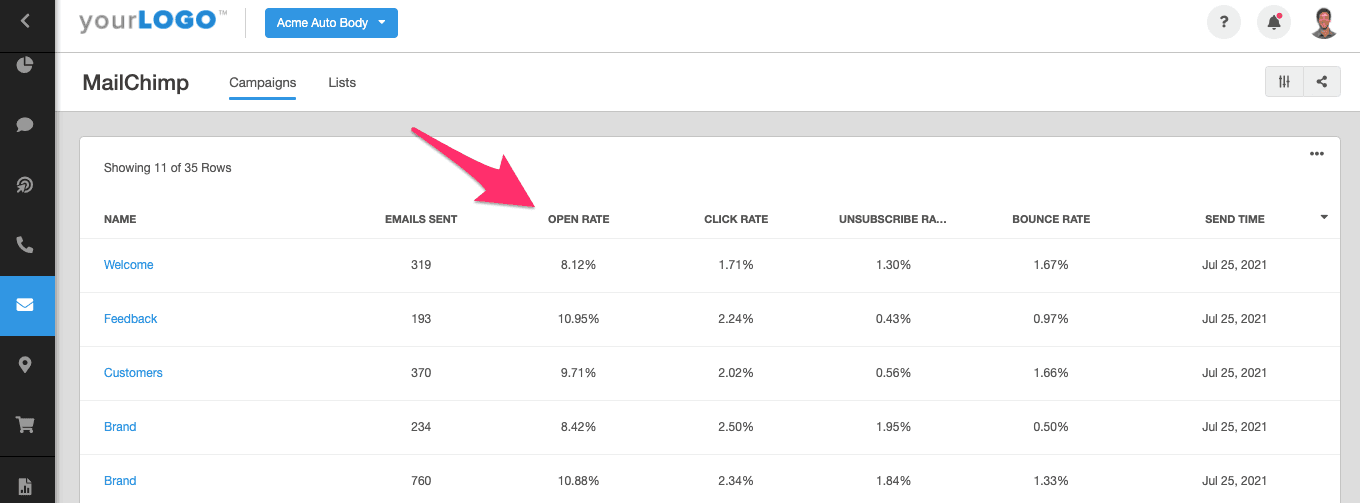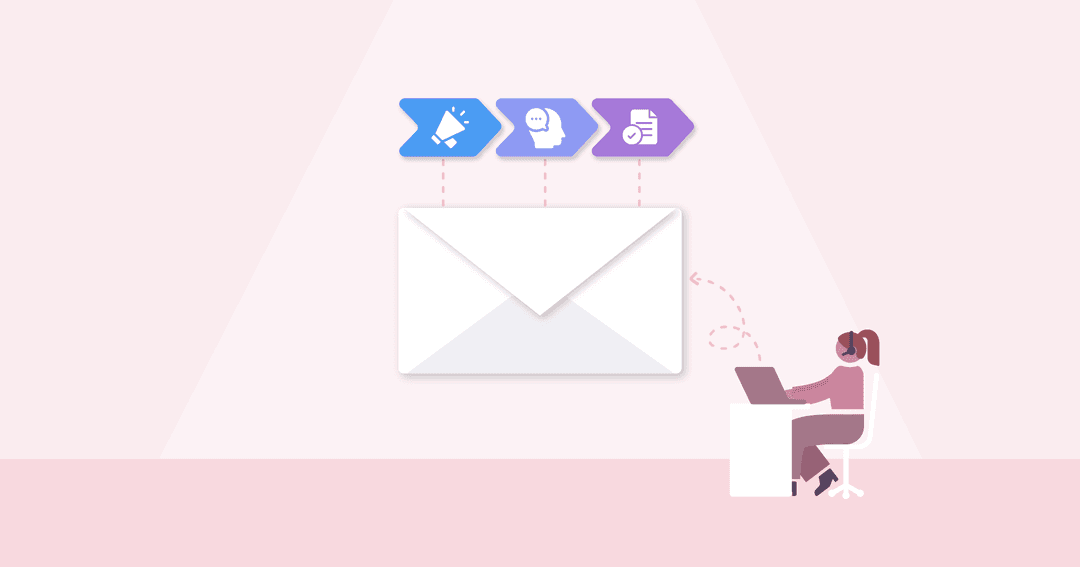Table of Contents
Table of Contents
- What Are the Stages of the Buyer's Journey?
- Emails for Each Stage of the Buyer's Journey
- Emails to Use in the Awareness Stage
- Emails to Use in the Consideration Stage
- Emails to Use in the Decision Stage
- Special Considerations for Each Stage in the Buyer's Journey
- Final thoughts on Crafting the Perfect Email for Every Stage of the Buyer's Journey
7,000+ agencies have ditched manual reports. You can too.
Free 14-Day TrialQUICK SUMMARY:
Emails for every stage of the buyer's journey target the right message at the right moment, increasing engagement throughout the customer lifecycle. This article offers valuable advice on crafting strategic emails tailored to each stage, ensuring content aligns with client needs, and optimizing engagement times. These email strategies build trust and satisfaction, leading to more successful conversions for a client's business.
Sending the right email at the wrong time is a surefire way to lose customers.
Most companies send emails based on a simple "if this, then that" formula.
In reality, your customers are more complex than that and with a better thought process, you’ll see that email marketing can be much more effective for you.
In this article, we'll look at email marketing in relation to the different stages of the buyer's journey and give you specific, actionable examples of the content that is most appropriate to send to your leads in each stage.
What Are the Stages of the Buyer's Journey?
The customer journey to make a purchase is a three-step process involving: Awareness, Consideration, and Decision. Companies try all kinds of different tactics to get people from one stage to the next, including email sequences, retargeting, promotions, and more.

They use different messages at each stage to compel prospects into taking action.
It is crucial to understand the stages of the buyer's journey so that we can craft appropriately targeted emails to our leads. The content you send will differ based on where they are in their journey.
To send better emails, it is important to know what stage a lead is at.
The Awareness Stage
The awareness stage involves informing your prospects about their problem and letting them know that there is a solution. You might also start telling them that your product provides such a solution and creating interest around it. What makes this stage different from the others is that these prospects have little or no intention of making a purchase right away.
They're not looking to buy anything new, but might still be interested in knowing more about what you offer just in case they ever do change their mind.
Here are some examples of how to communicate with leads who fall into the awareness stage:
Show them what your company is all about and how you're better/different from competitors.
Use ads, blog posts, videos, or other forms of social media to create buzz about your product.
Share tips and stories that address common issues faced by prospects in the market you cater to.
This delivers value to your audience and positions you as an authority in your field.
The Consideration Stage
In this stage, leads are starting to pay closer attention to solutions like yours after hearing about them from sources they trust. They've started researching on their own time (online mostly) but have not yet committed to making a purchase now or anytime soon—they're just weighing options at this point.
This phase may last for days, weeks, or even months depending on the problem your leads have, so it's important to maintain regular communication with leads and make sure you're getting in front of them at this stage as much as possible.
The way I've found to do that best is by offering value through content marketing that helps prospects at each step of their decision-making process. Your prospects are here looking for more information. They want to know more about your product, what makes it special, and how it can help address their problems.
Tips are a great way to provide value during this stage:
Give consumers an overview of the features you offer.
What does your product do?
How can they benefit from it?
List down common questions prospects might ask about your solution.
Provide different sales pitches you can use to talk about a product with different audiences (customers, investors, etc.).
Share case studies of how customers have benefitted from the solutions your company provides.
Publish articles listing your product's key features/benefits and share tips on how prospects can get the most value out of them.
Publish testimonials from customers who have used your products and services before.
The Decision Stage
The decision stage occurs when prospects are ready to buy. It is here your sales funnels and marketing efforts will come into full force, trying to close deals as efficiently as possible.
The content you create during this stage is similar to the content that you would publish in the awareness stage. What's different, however, is your intent. In this stage, we want to provide value but also position our products and services as invaluable resources people should buy into.
Here are some ways you can expose your leads to content that increases their interest in purchasing:
Share how-to guides on using one of your products or services.
Share tips about different features they might not have known about.
Publish case studies where prospects were able to get the most value out of a product and explain why it's the best solution they could've chosen.
List down recent successes and announce new developments related to what you offer.
Conduct webinars explaining product specifics and giving away information for free.
Send out surveys asking prospects what they're looking forward to in your products/services and how you can improve them further.
Emails for Each Stage of the Buyer's Journey
As mentioned before, the type of content you're sending out should be dependent on where leads are in their journey. In this section, let's take a look at specific examples of emails we’ve used for each stage.
Emails to Use in the Awareness Stage
Email 1: Send your subscribers the top 10 most popular posts on your blog and share more details about the company, including, why it was founded, the people behind the product, and so on.
Email 2: Host a webinar where you share how your product helped different businesses solve their problems (such as a recent case study) and offer some tips on how to get the most value out of it.
Email 3: Invite leads into your private community where they can engage with other users who have used your product/service before.
All of these emails are designed to do one thing—raise interest in what you're offering and expose leads to content that provides value while positioning your company as someone they should consider buying from.
Instead of asking leads to go out and find your product/service, show them how what you've got can benefit them so that they'll come to you when they need the solution that you offer.
Emails to Use in the Consideration Stage
Email 1: Publish a survey asking prospects what they're interested in learning about and how you can help them out. Ask for honest feedback on what they're hoping to get from your product/service.
Email 2: Announce a new product or service launch along with why prospects should be excited about it. Share how you implemented features that people have asked about previously and how now is their chance to get them for free (or at a discounted price).
Email 3: Publish testimonials from customers who are currently using one of your products/services to back up their claims. These testimonials should feature customers speaking about the problem they had before coming across your product and where they are at now.
Email 4: Send prospects a link to your company's video channel and ask them which videos they'd like to watch first (this is also another great way of getting more feedback). You're now at a point where leads are taking the time out of their day to watch your content, so that must mean you did something right.
All of these emails are designed to provide value without asking prospects to invest as much time and effort into learning new things.
Emails to Use in the Decision Stage
Email 1: Offer a free trial to download some of your product/service's best features, and be sure to ask readers to send you any questions they have about it.
Email 2: Let prospects know that you've just updated a tool or service for them because it helped solve their problem, and then list out the different things that are now available in the newest version (updates).
Email 3: Contact prospects personally and ask if they have any questions about the product before they go ahead and invest in it.
Email 4: Send a personalized email from your CEO to tell them that you've created something new, for example, this could a highly requested feature.
Email 5: Let your audience know that you've incorporated some of the features that they requested to be added into the next version of your product/service, along with a screenshot or two as a bonus.
Special Considerations for Each Stage in the Buyer's Journey
If you're not careful, it's easy to forget to tailor content for the different stages in the buyer's journey. This is especially true if you have a sales team that doesn't always understand how important it is to create unique experiences for each one of your prospects.
While there are no hard and fast rules when it comes to crafting emails for each stage of your buyer's journey, here are some special considerations that might help:
1: Be aware of what a lead is thinking about at different points in their journey. Their concerns can drive what kind of content you'll want to produce and what sort of language/tone you should use in your email - this will hugely affect the open rates of your emails.

2: You can save a lot of time by using free survey tools like Typeform or SurveyMonkey to ask people what they are interested in hearing about when you first reach out to them. Listen to their concerns and make sure that your content answers any questions they may have.
This is also beneficial because it tells you how much information you need to provide for prospects at each point in the journey. If there's something that they don't understand, then your email will help clear up any confusion and prevent them from instantly losing interest before even giving your business/personal brand a chance.
3: Be sure to create an easy way for leads to get into contact with someone if there are still many unanswered questions. If you don't, they'll lose interest and never end up hearing about your content.
4: You must make your email unique in some way. If it doesn't vary at all from what other companies are sending out to leads in the same stage of the buyer's journey, then your recipients probably have seen it before.
This is also a good time to test any new ideas or concepts out on prospects so that you don't risk wasting money later on. This sometimes happens when developing ideas further into full-blown products/services with membership fees attached - without having ensured that your target market is actually interested in what you’re offering.
5: A lot of the time, especially in a lifestyle kind of business, we want to create different content based on the lead's role/job title within their organization. That doesn't mean just changing up the wording or writing from a business perspective, it means creating separate materials for salespeople, marketers, leaders, and executives.
If you've created something new that will appeal to these types of people specifically (and not just anyone else), then you have a more solid chance at getting them to pay attention to what you're saying because you're speaking directly to their needs.
In addition, this can also tell prospects whether or not your product/service is good enough for someone in that specific role. It's okay if you don't want to spend a lot of time doing this because your goal is to get the lead/prospect into your sales pipeline in any way that you can. Just take as much of their information as possible, create separate versions of the same content and start sending them off.
6: The final tip for sending emails during a lead's journey is to create an easy way for them to share what you're saying with others in their company. This can either be done through social media or by asking interested parties to provide contact information for potentially interested parties through an email capture form somewhere on your website.
Just make sure that the opt-in form isn't too intrusive or overly wordy because most prospects won't want to fill it out - or simply won’t have the time to do so.
7: Track your email KPIs. This is a crucial final step to ensure that your emails are generating the results that you want. Without tracking your key performance indicators (which will vary from business to business), it will be impossible to know what’s working and what’s not, which means that you won’t be able to improve performance over time.

Final thoughts on Crafting the Perfect Email for Every Stage of the Buyer's Journey
In conclusion, the customer's journey is often difficult to navigate and optimize. By keeping the above tips when it comes to email marketing, you will be able to provide prospects with the right content that they want at the times when it's most convenient for them.
In other words, you will be able to guide your lead toward what you need from them every step of the way, thereby increasing their confidence in your company and increasing both their level of trust as well as overall satisfaction. If done right, then this can result in many valuable leads making it to a sale.

Written by
Hanson Cheng is the founder of Freedom to Ascend. He empowers online entrepreneurs and business owners to 10x their business and become financially independent. You can connect with him here.
See how 7,000+ marketing agencies help clients win
Free 14-day trial. No credit card required.





